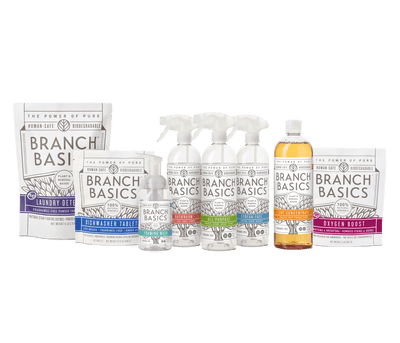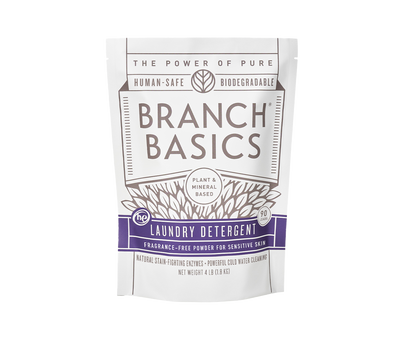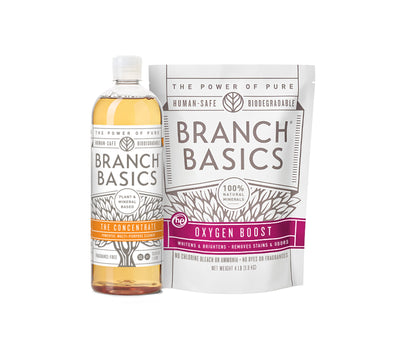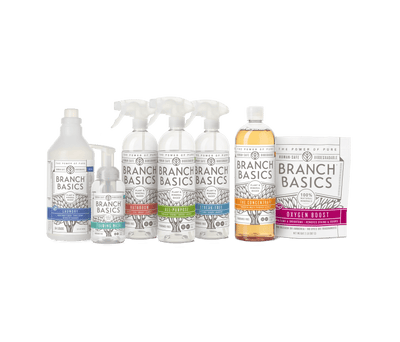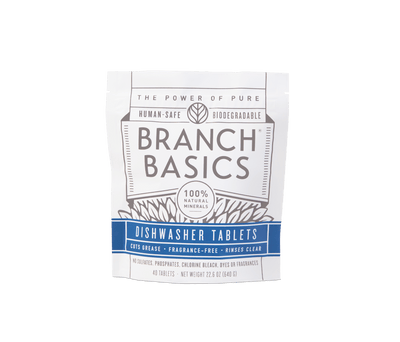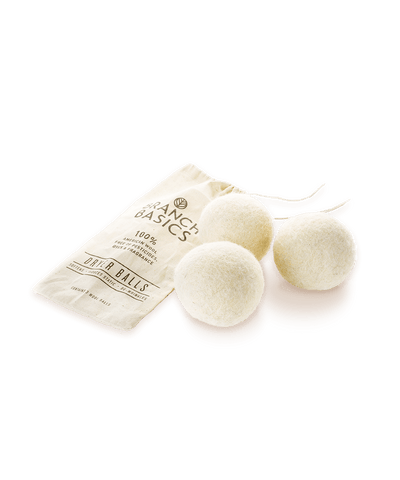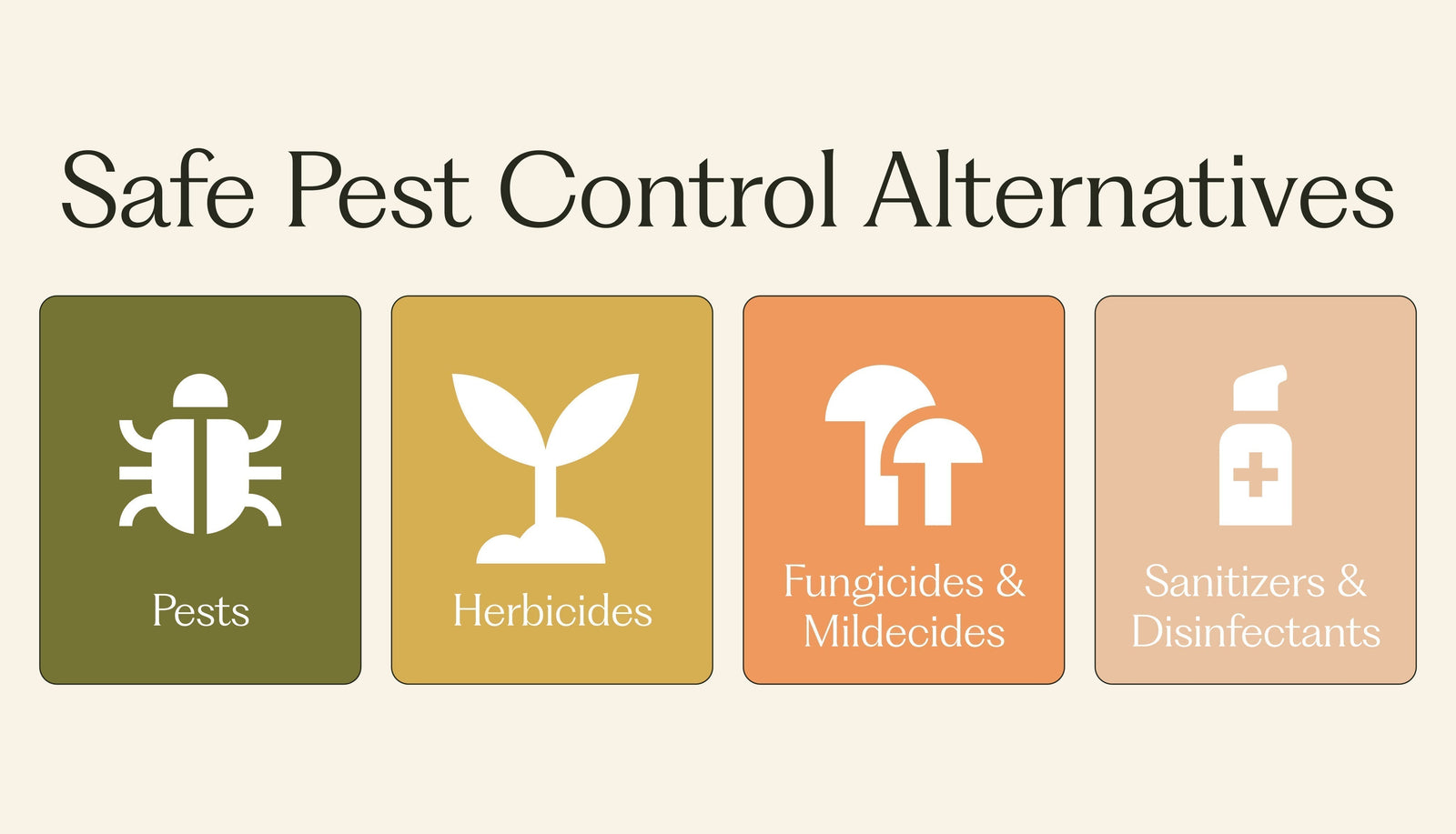How To Replace Toxic Pesticides: Our Ultimate Guide
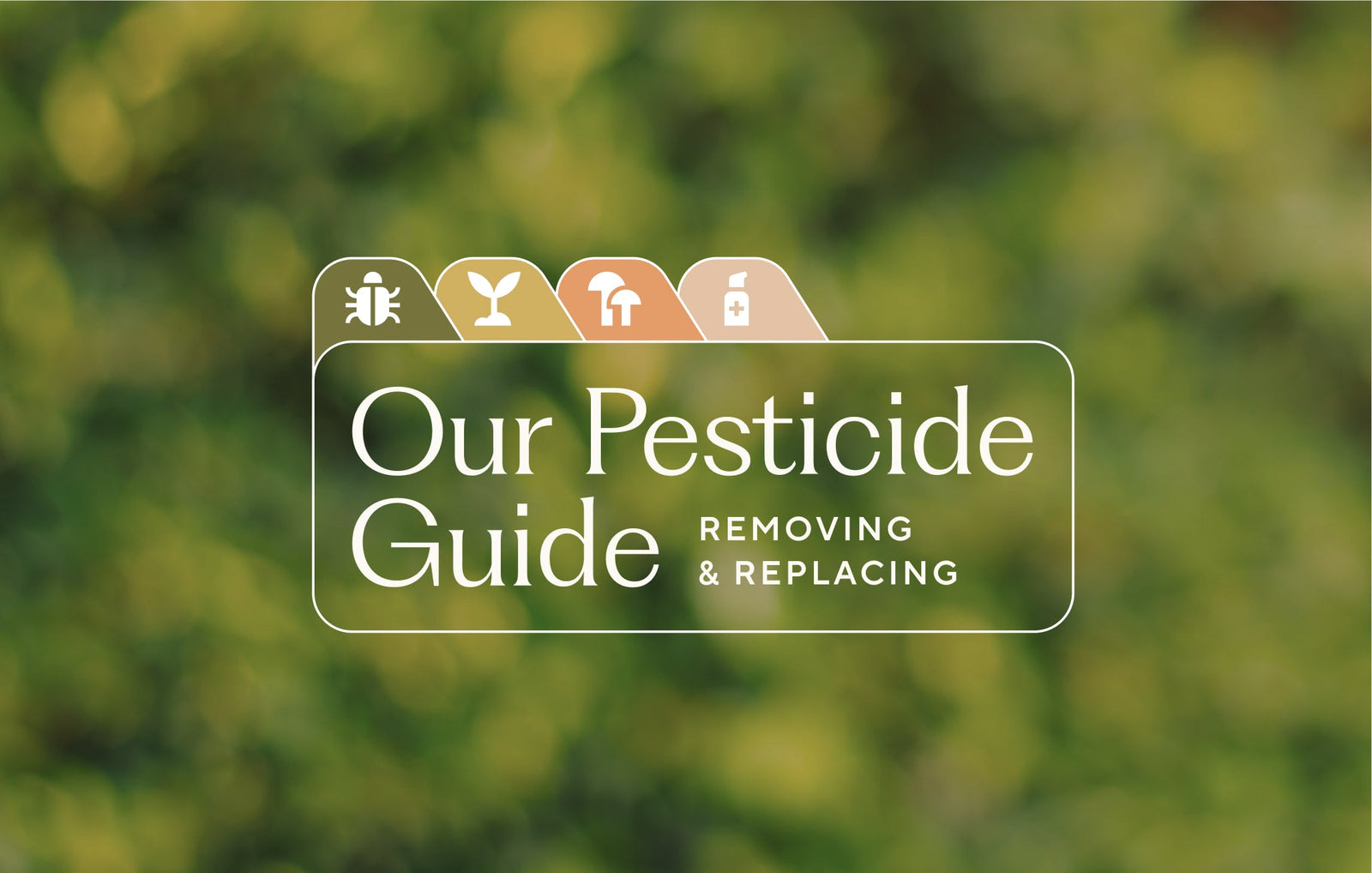
Pesticides and herbicides are among the most dangerous products in the home. The suffix "-cide" in a word on a label means kill. Pesticides, herbicides, biocides, fungicides, and mildewcides are made to kill.
Storing pesticides in the home creates a toxic low-level synthetic chemical soup that the body has to detoxify. Removing them from your home and attached garage improves the air quality and takes a tremendous load off the body’s detoxification system, allowing that energy to be used instead for regeneration and repair.
Multiple hazards are associated with pesticide use in the home. Low-dose, chronic exposure can negatively impact the nervous system, the respiratory system, and the reproductive system. Pesticide exposure has been linked to ADD/ADHD, Alzheimer’s, Asthma, Autism, Cancer, Parkinson’s, endocrine disruption and more.*
Below, we’re sharing ways to replace those toxic pesticides and keep your home and yard healthy.

Step 1: Remove Pesticides
We always recommend making a clean sweep of pesticides from the home. There’s no reason to review labels, just take them ALL out!
Remember, even if you are not using them, the contents are escaping and polluting your home’s air.
Walk through your home and check in cabinets, under sinks, in bathrooms, in the laundry room, closets, and attached garage.
Don’t forget herbicides and commercial fertilizers (destroy the microbiome of the soil) in attached garages.
Once you have removed from indoors, dispose of pesticides properly.
Next up? Replace with human-safe alternatives. Check out our Human-Safe Pesticides Alternatives List

13 Pesticides & Herbicides to Remove From the Home
Here are 13 pesticides and herbicides to remove from your home and why.
Pesticides
- Research shows that there are widespread pesticide residues in most American homes, and the amount of pesticides found in the air in homes is typically greater than expected due to tracking in pesticides from outdoors.
- Remove all insect repellents, DEET, herbicides, mosquito sprays, ant, wasp, and roach sprays, flea and bed bug treatments, foggers, lice shampoos and treatments from the home and consider clean up measures described in the Replace section of this guide.
Herbicides
- Herbicides like Roundup are used to kill lawn weeds, used more than other pesticides, and are undermining our health. Remove them from your home and switch to alternative safe methods of lawn and garden care.
Conventional Fertilizers
- Conventional fertilizers deplete the soil and kill a large percentage of the beneficial soil microorganisms. Remove from home and garage.
Products Labeled as Sanitizers or Disinfectant
- Many of these products contain EPA registered pesticides which are designed to kill. The use of antibacterial products is weakening our immune systems. Some exposure to germs is helpful since it allows our immune systems to build up its own resistance.
- In fact, the CDC only recommends using sanitizers and disinfectants when absolutely necessary due to the spread of resistant superbugs.
Fungicides and Mildewcides
- Unfortunately, many who have had their homes treated for mold have gotten sick from the products used for cleanup. Using a fungicide or mildewcide to remove mold is exchanging bad for bad.
- For many people bleach is the go to mold killer. Bleach is highly irritating and corrosive to the skin, lungs, and eyes. Fumes from bleach can cause DNA damage, cancer, asthma, and a host of other illnesses.
Antibacterial Products (Especially Those Containing Triclosan)
- Although Triclosan is banned in soaps and body care products, it is still allowed in other products in your home. Read all your product labels!
- Triclosan can lurk in toothpastes, mouthwashes, shaving creams, cosmetics, deodorants, socks, laundry detergents, etc. Learn more about the harmful health effects of Tricolsan.
Lawn Care Services
-
Despite the growing evidence that the herbicides used by lawn care services are hazardous to public health and the environment, the use of these services is exploding.
Flea/Tick Collars, Flea Bombs and Treatments
- Your pets deserve the best and they are very vulnerable to pet products intended to kill fleas and ticks. These pet products poison not only the pests, but also the pet and the owner. Pregnant women, young children, infants, the chronically ill, and the elderly are especially at risk to exposure.
Moths
- Never use moth balls. They are very toxic and especially toxic to animals.
Rodent Poisons
- Remove baits from the home as they are poisonous to dogs, cats and humans.
Mosquito Abatement Systems - Yard Insect Foggers
- Misting systems installed around the perimeter of the home to kill insects should not be used.
- These systems use pyrethrins and pyrethroids and piperonyl butoxide – all have been implicated in chemical injury to infants, children, people with weakened immune systems and the elderly.
Tubes in Wall Pest Control
- Unfortunately, this is becoming popular in newly built homes and is touted as being called “the cleanest, greenest, most effective and convenient pest control system ever”. If you are in a home that has these tubes, stop the service.
Stop All Reoccurring Pest Control Services
- Many people are deceived by the misinformation put out by the pesticide companies. They state that they are using a natural, therefore safe product. Natural does not always mean safe - i.e. lead, arsenic, mercury, etc.
- Synthetic pyrethroids that have a similar structure and mode of action to pyrethrins are also used. Some of the common pyrethroids are Ambush, Ammo, Aztec, Pounce, Scourge, and Warrior.
- These pesticides are endocrine disruptors, neurotoxic, and can trigger allergic reactions. The residue will need to be cleaned up (more to come on that)!
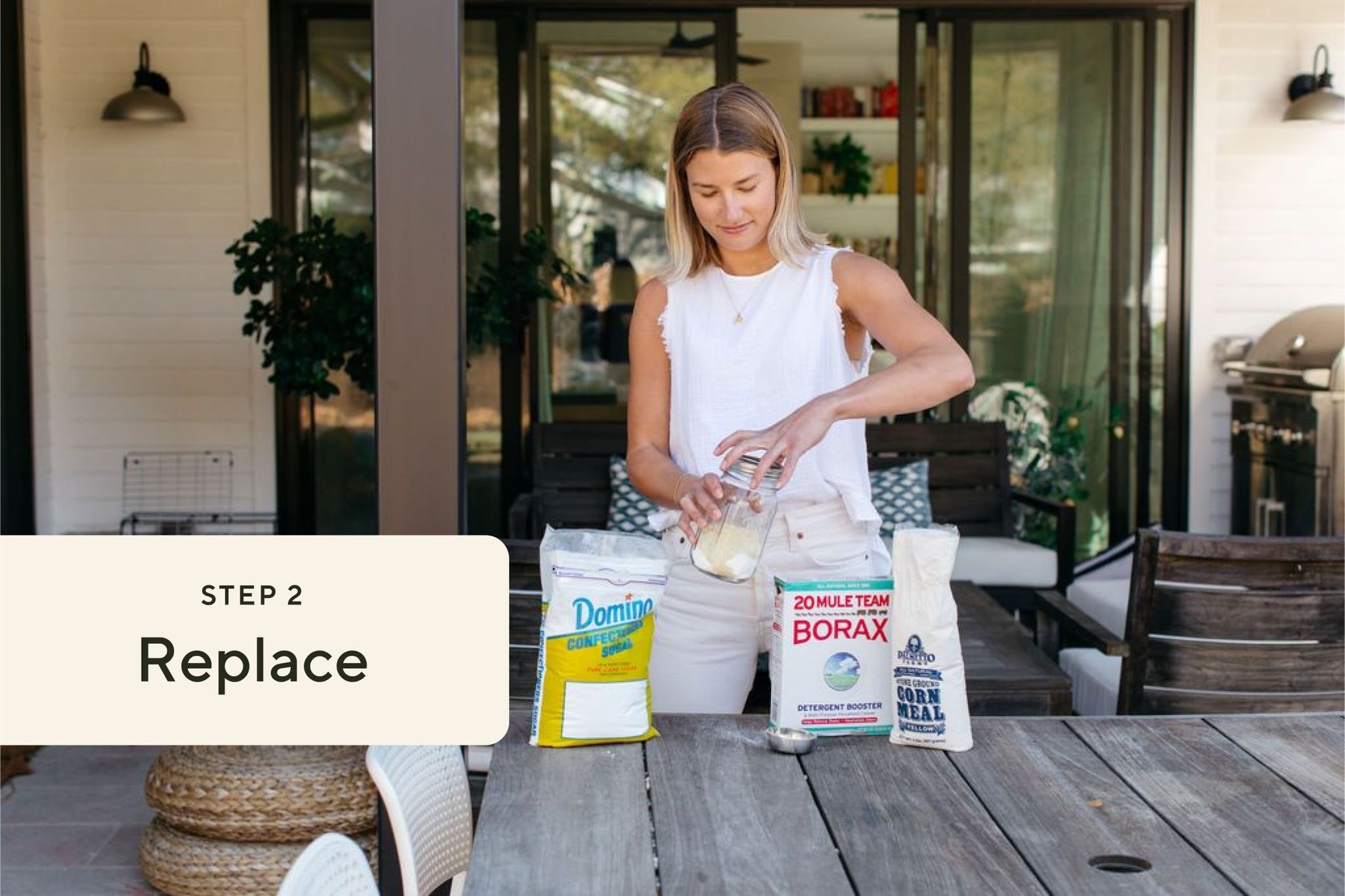
Step 2: Replace Pesticides
After completing the removal of all pesticides, you have already dramatically improved your air quality and your health! Now you are ready to “Replace” with safe healthy alternatives.
After removing all pesticide products in the home, there are four steps to take:
1. Take General Measures to Reduce Exposure to Pesticides
To get started, check out these 25 Tips for Controlling Pests In and Around Your Home.
It's best to have a welcome mat at the front door for people to wipe their feet on before entering. Even better, consider having people remove shoes when they come in your home.
2. Reduce Entry of Pests Into Home
Remove all ground cover, wood chips, or any potential insect habitats from around the home.
- Check that you have appropriate grading and drainage and make sure openings (such as soffit vents) are blocked with tight screen or mesh where appropriate.
- Weather tightness is important. Caulk areas to prevent insect entrance. Great non-toxic economical caulk that fills up to 1 inch gaps, is paintable & comes in many colors Titebond Weathermaster Sealant.
- Provide for the prevention of excess moisture buildup from within, including humidity regulation that discourages condensation, extraction fans and windows that allow cross ventilation.
- Make sure to always clean up areas leaving no food or crumbs around.
- Integrated Pest Management – the safe and natural options we suggest may take care of your needs, but if you need professional help always specify "non-toxic pest control", not just "least toxic" when using an exterminator.
- Avoid all pyrethrin/pyrethroid/chrysanthemum flower-based pesticides. Research all materials proposed.
3. Replace With Only Safe and Natural Alternatives
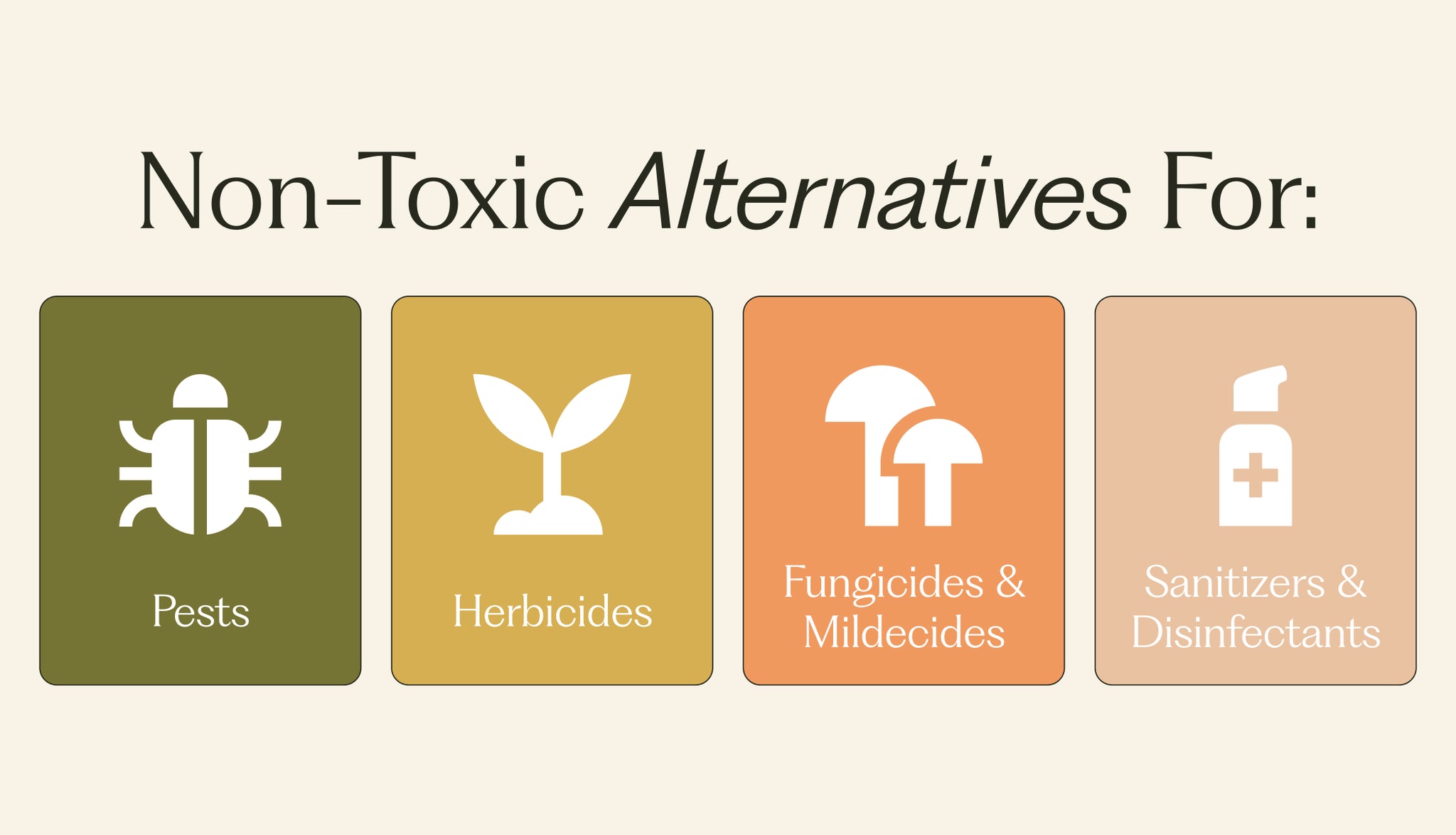
Click to check out our full list of Safe and Natural Alternatives!
4. Clean Up Pesticide Residue Left In The Home
The following will help to reduce the pesticide load in your home if it has a pesticide history. Each time you clean the house - it will help to reduce the levels. Also consider a complete deep clean of the home as an option if serious contamination is an issue.

Steps to Remove Pesticide Residue
Step 1
HEPA vacuum all surfaces. Pesticides ride on dust and this first step will lower the level.
Did you know conventional vacuums typically make the air quality worse after vacuuming?
Ideally, start with the ceiling, then the walls, and last the floors. Vacuum all surfaces in the home - furniture, knick knacks, books on the way.
Step 2
Pay attention to baseboards. Typically when a home is treated by a pesticide service, the baseboards are treated.
- Enviro - One - If your house was built before 1988, you will need to clean with Enviro - One. This is a fragrance-free proprietary blend formula that breaks down chlorinated pesticides like Chlordane, Heptachor, Dieldrin and more that were used at this time.
- Super Washing Soda – If your home was built before 2005, you'll want to use a sodium carbonate solution that breaks down organophosphate pesticides. To use, mix 2.4 teaspoons of Super Washing Soda per gallon of distilled water and let it dissolve together. Clean all surfaces with the mixture and then wipe down all surfaces with distilled water if there is residue.
Other ways of reducing your pesticide exposure include:
- Buying organic and/or naturally-grown food and non-GMO food as much as possible.
- Utilizing the Dirty Dozen and Clean Fifteen lists to help you prioritize the most important produce to buy organically.
- Always washing produce thoroughly.
- Keeping a no-shoes-indoors policy.
- Avoiding DEET-containing bug sprays and opting for natural alternatives.
- Educating your schools, workplaces, etc. about natural pest control alternatives.
- Replacing bleach (an EPA-registered pesticide) with safer alternatives
- Buying organic clothing, sheets, and towels as much as possible (second-hand clothes are a wonderful, affordable way to do this)
- Talking with your local parks department about integrative pest management alternatives and knowing their spraying schedule so you can avoid parks on those days.
Toss the Toxins with Branch Basics
In closing, although we may not be able to control all types of pesticide exposure, we can create a safe-haven at home by following these natural pest control steps.
Try our Branch Basics starter kit to start cleaning your home with healthier products!
